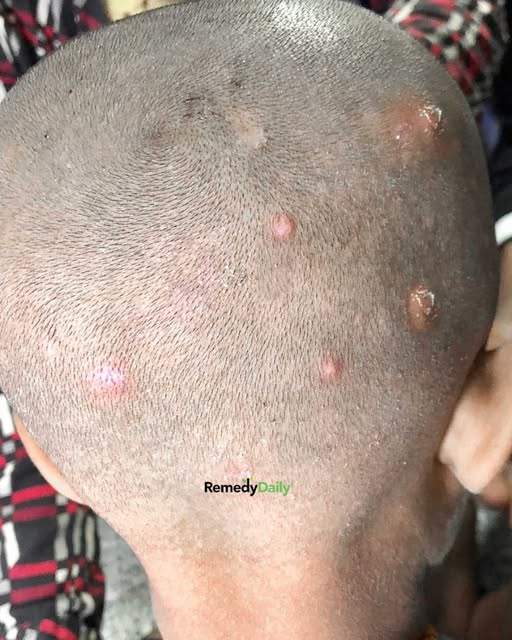Discovering unusual bumps on your child’s scalp can be a cause for concern, especially when the next available doctor’s appointment is weeks away. As a parent, it’s natural to worry about your child’s health and comfort, and you may feel anxious about what these bumps could mean. While waiting for a professional medical evaluation, there are steps you can take to better understand the situation and alleviate your child’s discomfort.
In this article, we will explore potential causes of scalp bumps, ranging from common conditions like folliculitis to more serious issues that require immediate attention. We’ll also discuss home remedies, over-the-counter treatments, and hygiene practices that can help manage the situation. By understanding these aspects, you can make informed decisions and provide the best care for your child until you can see a healthcare provider.
1. Understanding Scalp Bumps: Common Causes
Scalp bumps can arise from various causes, and identifying the underlying issue is crucial for effective treatment. Common causes include folliculitis, sebaceous cysts, and boils. Folliculitis is an inflammation of the hair follicles, often caused by bacterial or fungal infections, and can result in small, red, and itchy bumps. Sebaceous cysts are non-cancerous lumps filled with sebum, typically appearing as smooth, round bumps under the skin.
Boils, or furuncles, are painful, pus-filled lumps caused by bacterial infections, usually Staphylococcus aureus. They can grow larger than 2 centimeters and may require medical intervention. Other causes of scalp bumps include allergic reactions, insect bites, and dermatological conditions like psoriasis or eczema. Understanding these possibilities can help you narrow down the cause and determine the best course of action.
2. Identifying Scalp Folliculitis
Scalp folliculitis is characterized by small, red, and itchy bumps around hair follicles. It can be caused by bacterial, fungal, or viral infections, as well as irritation from hair products or tight hairstyles. The bumps may contain pus and can be tender to the touch. In some cases, folliculitis can lead to hair loss or scarring if not properly managed.
To identify folliculitis, examine the bumps closely for signs of inflammation and pus. If your child frequently scratches their scalp or complains of itching, folliculitis may be the culprit. Maintaining good scalp hygiene and avoiding irritants can help prevent and manage this condition.
3. Recognizing Boils on the Scalp
Boils, or furuncles, are painful, pus-filled lumps that develop when bacteria infect hair follicles. They often start as red, tender bumps that gradually enlarge and fill with pus. Boils can be quite painful and may cause swelling in the surrounding area. They typically measure more than 2 centimeters in diameter and can occur singly or in clusters.
If your child has a boil, it’s important to avoid squeezing or popping it, as this can spread the infection. Applying warm compresses can help the boil come to a head and drain naturally. If the boil does not improve or if your child develops a fever, seek medical attention promptly.
4. When to Seek Immediate Medical Attention
While many scalp bumps are benign and can be managed at home, certain signs warrant immediate medical attention. If your child experiences severe pain, fever, or swelling that spreads beyond the scalp, it’s crucial to seek professional help. Additionally, if the bumps are rapidly increasing in size or number, or if they are accompanied by symptoms like difficulty breathing or swallowing, consult a healthcare provider immediately.
Other red flags include persistent or recurrent bumps that do not respond to home treatments, or if your child has a weakened immune system. In such cases, early intervention can prevent complications and ensure appropriate treatment.
5. Home Remedies to Soothe Painful Scalp Bumps
Several home remedies can help alleviate discomfort from scalp bumps. Applying warm compresses to the affected area can reduce pain and promote drainage of pus-filled bumps. A solution of diluted tea tree oil, known for its antibacterial properties, can be applied to the scalp to help reduce inflammation and prevent infection.
Aloe vera gel is another soothing option, providing relief from itching and irritation. Ensure your child avoids scratching the bumps, as this can exacerbate the condition and lead to infection. Maintaining a clean scalp and using gentle, hypoallergenic shampoos can also aid in soothing the scalp.
6. Over-the-Counter Treatments to Consider
Over-the-counter treatments can be effective in managing mild scalp conditions. Antibacterial or antifungal shampoos containing ingredients like ketoconazole or selenium sulfide can help treat folliculitis and dandruff. Topical creams or ointments with hydrocortisone can reduce inflammation and itching.
For pain relief, consider giving your child acetaminophen or ibuprofen, following the dosage instructions for their age and weight. If over-the-counter treatments do not improve the condition within a week, consult a healthcare professional for further evaluation.
7. The Role of Hygiene in Preventing Scalp Issues
Good hygiene practices are essential in preventing scalp issues. Encourage your child to wash their hair regularly with a gentle, sulfate-free shampoo to remove dirt, oil, and sweat. Avoid sharing personal items like combs, hats, or towels, as these can spread infections.
Ensure your child rinses their hair thoroughly to remove all shampoo and conditioner, as residue can irritate the scalp. If your child participates in sports or activities that cause sweating, prompt showering and scalp cleansing can help prevent folliculitis and other conditions.
8. Popular Viral Hacks: Do They Really Work?
With the rise of social media, numerous viral hacks claim to cure scalp issues overnight. However, it’s important to approach these with caution. Some popular remedies, like using apple cider vinegar or baking soda, can disrupt the scalp’s natural pH and cause irritation.
While some hacks may offer temporary relief, they are not a substitute for evidence-based treatments. Always research the safety and efficacy of any home remedy before trying it on your child, and consult a healthcare professional if you are unsure.
9. Managing Discomfort Until Your Doctor’s Appointment
While waiting for your doctor’s appointment, focus on managing your child’s discomfort. Encourage them to avoid scratching or picking at the bumps, as this can lead to infection. Keep their nails trimmed to minimize damage from scratching.
Ensure your child stays hydrated and eats a balanced diet to support their immune system. Applying a cool compress can provide temporary relief from itching and inflammation. If your child is in pain, consider giving them an appropriate dose of over-the-counter pain medication.
10. When to Consider Telehealth Options
If your child’s symptoms worsen or you are unable to secure a timely in-person appointment, consider telehealth options. Many healthcare providers offer virtual consultations, allowing you to discuss your child’s symptoms and receive guidance from the comfort of your home.
During a telehealth appointment, be prepared to describe the appearance and progression of the bumps, as well as any accompanying symptoms. The provider may recommend specific treatments or suggest an in-person visit if necessary.
11. Preparing for Your Doctor’s Visit
To make the most of your doctor’s appointment, prepare a list of your child’s symptoms, including when they started and any changes over time. Note any home treatments you’ve tried and their effects. Take clear photos of the bumps to show the doctor, especially if they change in appearance.
Prepare questions about potential causes, treatment options, and preventive measures. Having this information ready will help you and the doctor develop an effective plan to address your child’s scalp condition.


